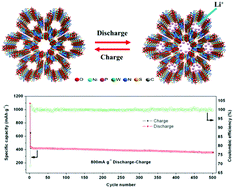An inorganic–organic hybrid supramolecular framework as a high-performance anode for lithium-ion batteries†
Abstract
Herein, an excellent anode was achieved for a lithium-ion battery based on a polyoxometalate-organic framework [Ni5(OH)3(trzS)3(en)(H2O)(B-α-PW9O34)] for the first time. It can deliver a capacity of 710 mA h g−1 at 100 mA g−1 after 50 cycles and a high capacity retention of 82.2% after 500 cycles at a high rate of 800 mA g−1, which is supposed to be due to the unique porous characteristic and high chemical stability of the proposed anode. The higher capacity was ascribed to Ni and W of the building unit taking part in lithium storage.



 Please wait while we load your content...
Please wait while we load your content...